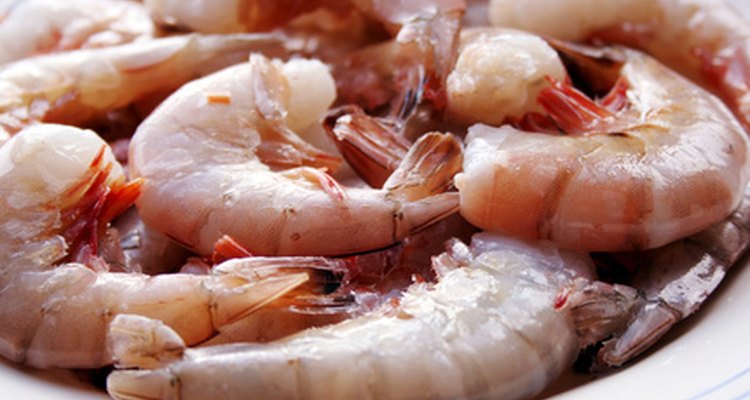
Shrimp is a type of shellfish that comes in a variety of sizes, types and prices. They are often available to buy frozen, but if you want the best flavor, buying them fresh is highly recommended. Because of the perishable nature of this shellfish, however, it is necessary to confirm that the shrimp that you are buying is actually as fresh as advertised in order to get your money's worth and to keep from getting sick.
Ask if you can get a closer look at the shrimp that is available at the seafood department of your grocer or at a fish market. Check that the head with antennae is still attached as, according to the Richmond Times Dispatch, these are less likely to have been frozen. Avoid any shrimp with missing or shrunken eyes. Instead the eyes should have a prominent appearance in the head and appear glossy or shiny.
Look for shrimp that is still in its shell. If it is fresh, the shell should have a firm and glossy appearance. Black spots on the shell are an indication that the shrimp is no longer fresh was improperly rinsed and iced when it was originally harvested. Avoid yellowing near the tail or swimmerets of the shrimp, as this is a sign of excess Sodium Bisulfate usage.
Smell the shrimp for any offensive odors. Avoid any shrimp that has a rotten egg or ammonia smell, as this is an indication of decomposition. Be wary of chlorine smells as well as this is often used to mask offensive odors of shrimp that were not handled properly. Fresh shrimp should not have a strong odor and should smell of seawater or of seaweed.
Educate yourself on the correct color for the type of shrimp that you are interested in so that you can detect abnormal color. Shrimp can be of varying colors from greenish to brown. Shrimp that has spots of pink on the surface and white meat may not have been properly iced which will not only cause it to lose its freshness, but also means that it might be partially cooked.
Ask if you can touch one of the shrimp to make sure it feels moist and firm. Don't purchase it if it is dry and tough, as this is a sign that it has been frozen for a long period of time. A chalky or mushy texture is also a sign that shrimp is not fresh and has been handled improperly. If it is slimy, this is an indication that the shrimp has been frozen and is not fresh. A slimy feel comes from too much Sodium Tripolyphosphate, which is used to reduce dehydration during freezing.
Related Articles

How to Cook Frozen Shrimps That Still ...

How Long Can Shrimp Be Refrigerated?

How Can You Tell If Frozen Shrimps Are ...

Precautions With Fully Cooked Frozen ...

What Is the Dark Line on a Boiled ...

Is Grocery Store Fish Safe for Sushi?

How to Prepare Live Shrimp

Jumbo Shrimp Nutritional Facts

How to Blanch Frozen Shrimp

How to Thaw Frozen Cooked Shrimp Quickly

List of Foods Containing Shellfish

The Best Method to Store Fresh Oysters

How to Prepare and Eat Raw Shrimp

How to Absorb the Fishy Smell When ...

How to Use a Shrimp Deveining Tool

How to Steam Shrimp in a Rice Cooker
Do Sardines Ever Go Bad?

How to Know if Bacon Has Gone Bad

How to Cook Dead Crab

How to Remove Whelk Shells
References
Writer Bio
Mai Bryant is a Northern California writer who specializes in writing about health-related topics, fashion and relationships. She began writing online in 2005 but has freelanced privately for more than 10 years. Bryant's eclectic professional background as a medical technician, a licensed cosmetologist, copywriter and event planner allows her to write with authority on numerous topics.
Photo Credits
shrimp image by Liz Van Steenburgh from Fotolia.com